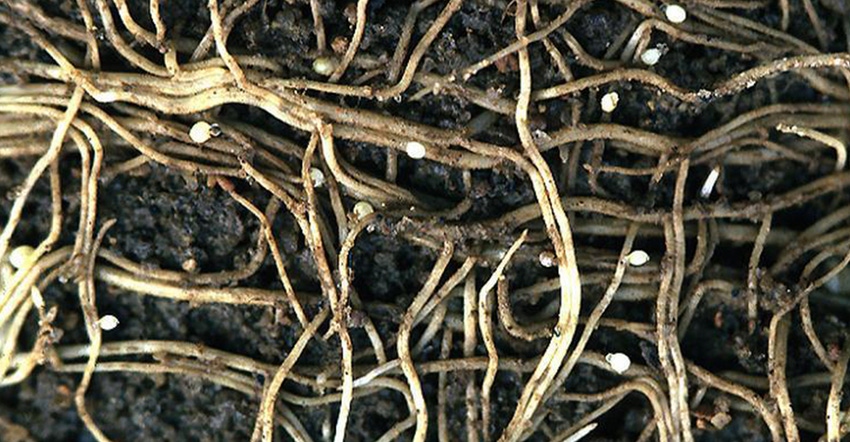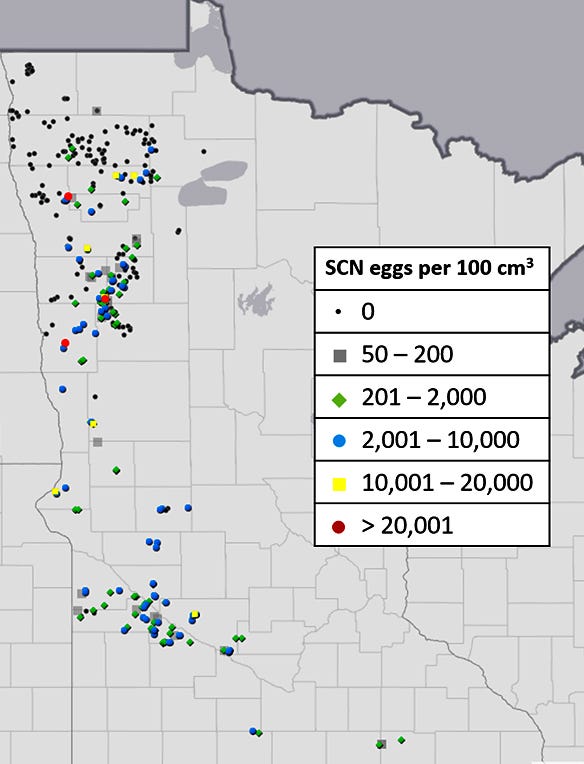
Farmers who participated in an industry-sponsored sampling and education program for soybean cyst nematode last year learned some valuable lessons.
Some learned for the first time that their fields had SCN.
Some learned their fields had higher SCN infestation than they originally thought.
Some learned that SCN populations were still high, even in SCN-resistant varieties.
And some learned that SCN levels were so high that they should plant other crops instead of soybeans to curb the infestation cycle.
Farmers with fields in 28 counties across Minnesota participated in the SCN sampling and education program sponsored by the Minnesota Soybean Research and Promotion Council and developed by University of Minnesota Extension.
A majority of the 363 samples came from the recently infested northwest region of the state. The program’s goals were to increase awareness about SCN infestations and threats to yield potential, and to encourage SCN sampling. Participating farmers were responsible for collecting and shipping samples. Other costs, such as testing and education, were covered by check-off funds.
Angie Peltier, University of Minnesota Extension educator, along with Jared Goplen, Extension educator, and Seth Naeve, Extension soybean agronomist, worked with growers and crop consultants on the program. After compiling data, this is what they learned:
• Half of the samples had SCN population densities below the limit of detection of 50 eggs per 100 cubic centimeter of soil.
• Half the samples tested positive. One sample submitted through the survey included the first documented infestation in Beltrami County.
Among samples testing positive, researchers learned:
• 43% had egg densities high enough to cause some yield loss on SCN susceptible varieties.
• 45% had egg densities high enough to cause yield loss even on SCN resistant varieties.
• 7% had egg densities so high that soybean yields would be impacted enough that planting soybeans would not be recommended.
Grower lessons
In a follow-up survey of participants, only 8% of respondents said they had previously routinely submitted soil samples for SCN analysis; 44% had never. Twenty-six percent of respondents were not previously aware that their field was infested with SCN. For 21%, the SCN population density was much higher than anticipated.
Having participated in the SCN sampling program, 91% indicated they were extremely likely or likely to continue periodically collecting SCN soil samples. After learning their sample's SCN egg counts, respondents said they plan to actively manage SCN, with 47% planning to plant a soybean variety with SCN resistance and 29% planning to plant a crop that is not a host of SCN.
Certified crop adviser Dorian Gatchell with Minnesota Agricultural Services, Granite Falls, worked with 18 growers and sampled 50 fields in Big Stone, Chippewa, Yellow Medicine, Renville, Lac Qui Parle and Redwood counties.
Gatchell gathered the majority of the samples after harvest during routine sampling operations. However, a few were taken in August during soybean aphid scouting when some symptoms were seen on the beans and the samples were taken to help diagnose what was being seen.
“Some of these growers had taken SCN samples in the past on other fields, but these [samples] were all new results,” Gatchell said. “A few of these growers have never taken a SCN sample because they have been led to believe that since they are planting resistant soybeans, there was no need to.”
Sampling results ranged from a high of 17,000 eggs per 100 cubic centimeters of soil to a low of less than 50 eggs. Compiling numbers within his own group of growers, Gatchell learned:
• 90% of the samples taken were positive.
• 38% have levels that should cause some injury to the soybeans.
• 12% have levels that serious injury can be expected.
• 14% have levels that are ‘close’ to numbers that serious injury could be expected.
• 38% had levels low enough that soybean resistance “should” work.
“This project has been the catalyst for some conversations,” Gatchell said. “For some growers, we have plans to do further SCN sampling. Others are looking at their resistance varieties, such as 88788 versus Peking. And some growers now understand possibly why their yields may not be where they want them to be.”
SCN impact
Soybean cyst nematode is a microscopic root-infecting worm that is the most yield limiting pathogen of soybean, responsible for annual yield losses of more than 95 million bushels in the North Central U.S., according to U-M scientists. Because aboveground symptoms tend to not be diagnostic or obvious, yield-damaging populations of SCN may be present long before producers are aware that a crop is at risk.
While Extension personnel, agronomists and other agricultural professionals repeatedly stress the importance of monitoring and managing SCN to maximize soybean production, many producers remain unaware of the threat that SCN poses or how essential monitoring population densities is to maintaining crop productivity.
 SCN SAMPLING DATA: Researchers collected data on soybean cyst nematode population density estimates from soil samplings gathered last year by University of Minnesota Extension for a soybean cyst nematode sampling and education program sponsored by the Minnesota Soybean Research and Promotion Council.
SCN SAMPLING DATA: Researchers collected data on soybean cyst nematode population density estimates from soil samplings gathered last year by University of Minnesota Extension for a soybean cyst nematode sampling and education program sponsored by the Minnesota Soybean Research and Promotion Council.

Research has shown that when SCN is present at moderate densities, planting resistant soybean varieties can improve soybean yields by more than 40%. Using Minnesota’s average yield of 50 bushels per acre and an average soybean price of $9.10 per bushel, the value of SCN management after a detection could be as high as $182 per acre, or $29,120 on a 160-acre field, according to U-M scientists.
Sampling time
When you take samples kind of depends upon a person's reason for sampling, Peltier said. Growers interested in diagnosing a problem with a soybean crop or learning for the first time whether a field is infested can collect samples at any time as long as the soil isn't too wet or too dry.
For a growers that already knows a field is infested, the recommendation is to collect samples after corn/wheat and after tillage the fall before soybeans to estimate the SCN population density to which the next season's soybeans will be exposed. Growers can also collect samples in the fall after soybeans to estimate the population density that the soybean crop supported.
“Regardless of sampling time, sample results only provide estimates and these estimates tend to be better when one collects more soil cores from a smaller land area than fewer soil cores from a larger land area,” Peltier said. “We also recommend that people sample fields periodically, sticking to the same time of year during the same point in the crop rotation. For example, in the fall after corn and before soybean, for an apples-to-apples comparison.”
Cost for sample analysis varies, Peltier said. She provided the following list:
University:
• Iowa State University: $20
• University of Minnesota Extension: $21
• University of Illinois: $25
• North Dakota State University: $30
Commercial:
• Minnesota Valley Testing Labs: $25
• Agvise: $28
About the Author(s)
You May Also Like






